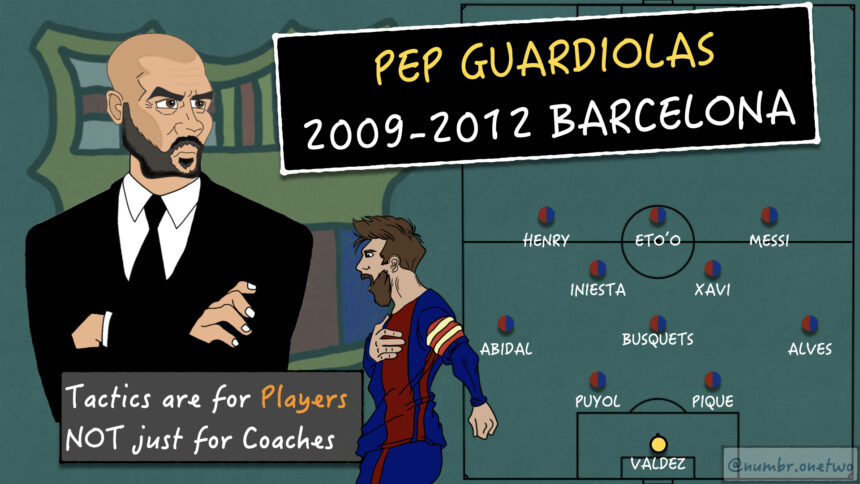Pep’s first few seasons in charge of a first division team were incredible and he managed to revolutionise football and achieve extraordinary results in his short stint. In this post we will discuss his treble winning side that managed 14 trophies in only 4 seasons.
The main thing that surprised many at first was Guardiola’s commitment to his tactics. Right from the beginning he sought to get rid of players that were not going adhere to his vision or didn’t have the right qualities. This even included legends such as Ronaldinho, Deco and Eto’o (although the latter did actually manage to remain for one season). Additionally, since taking over from the 2nd team, he put his trust in young players that became essential members of the squad like Busquets and Pedro. Along with this he brought in players that became big successes at Barcelona but also some who did not due to their failure to adapt and prioritise the team over themselves.
Guardiola’s preferred system, especially at the beginning was the 4-3-3. His main priority was to dominate the middle of the pitch and always have many passing options around the ball carrier. This era is famous for the tiki-taka style of play in which one or two touch passing was consistently and constantly performed.
 Build Up
Build Up
For the build up, the team would position their centre backs flat with their fullbacks slightly more advanced out wide. The holding midfielder created an option in the middle but behind the line of opposition attackers. Sometimes, for example against a pair of strikers, Busquets would occupy the space between the centre backs who, in turn, positioned themselves wider. This way, rather than the holding midfielder bringing the ball forward, one of the centre backs eventually had enough space to dribble forward into midfield. The wingers would try to hug the touchline.

Although, especially on the right side, with Alves and Messi, a rotation would occur where Alves took up a position as high and wide as possible and Messi dropped into an almost fullback position. As the ball was moved forward where the central midfielders were able to get more touches, the wingers created more width. Additionally, the opposition centre backs were often left with no one to directly mark as the striker dropped deep. In the figure below, the ideal positioning of the players is depicted.
Since this was new for many teams to play against, they were often able to swiftly progress the ball forward. The most important aspects of the build up was to always have a player on either wing, overload the midfield with numerical superiority and play short passes tirelessly to move the opposition around.
Movement and Positioning
As this Barcelona side were almost always able to retain possession for long periods even in the opponent’s half of the pitch, there are a few key points to consider. One of these has been touched upon already. In order to keep possession as well as move around the opposition, the players were never afraid to rotate. The player’s roles were not necessarily specific for the player, but rather Pep insisted that the positions were occupied. This meant that for example, if a winger went inside, the forward or full back would take up the vacant space. This ensured two things. The first, the team was always well balanced and occupied all of the important spaces. Through this, they were safer to prevent dangerous counter attacks and that it caused opposition confusion. Secondly, it meant that if an opposition player were to leave his position and follow a player, the space he left behind could immediately be exploited.

Of course, this Barcelona squad had the quality to get through using their short passing, however, if the opposition were able to organise themselves to prevent direct breakthroughs, the passes would slowly draw in the opposition nonetheless. Once the players were drawn in, the opposite side would still have a free player, who through a longer pass, could break the line. If a player in possession on the wing was not able to break the line fully, Pep’s team would refrain from crossing. Instead the ball would be recycled back into midfield to wear the opposition down further and begin another attack. This was somewhat of a necessity because of the lack of heading qualities in the front line. What would occur is the team would have possession around the opponent’s 18 yard box prodding away to see if any gaps could open up either through a defender’s error or through a well placed. Naturally, the forward players also had the ability to beat opponents one vs. one which was also a possible way to create an opening.
Out of possession
Although Pep’s side were often able to retain possession of the ball, they of course inevitably did at times. The defensive strategy had a single priority: win the ball back straight away. This meant counter pressing as soon as the ball was lost. Fortunately, due to the team’s ball keeping abilities, lost possession almost always occurred in the opponent’s half – even in the final third. To counter press, the player who could most effectively influence a forward pass would put immediate high pressure on the ball carrier. The other players surrounding would also close in on this player, trying to cut passing lanes but also attempting to prevent long balls. The use of the cover shadow was also a bonus here. In order to prevent a potential long ball behind the defence causing harm, the two centre backs would remain with the last striker. This high counter press caused the player on the ball to relinquish possession or to play a poor pass in which the counter press would continue.

Since this is a high intensity, demanding style, the press could only be achieved for a few seconds. If winning the ball back was not possible, the team would form a more conventional back 4 and tuck in the midfielders, usually Xavi and Busquets. However, since the opposition was often worn out from chasing the ball, as well as due to the danger of Barcelona’s forwards, moments of prolonged possession by the opposition were rare.
Shortcomings
Although the team was extremely successful, they were not without their failings. Most notably, losing to Inter Milan in the champions league under Jose Mourinho. The tactic employed quickly by most teams was to sit back with two blocks of four and to try to counter attack quickly. Of course, although many teams tried this, most were nonetheless unsuccessful. Because Pep’s side was so focused on keeping possession in the opponent’s half, they threw both full backs forward, the more offensive central midfielders were occupying the edge of the box and only the two centre backs and holding midfielder were guarding behind. This meant that if a team was able to avoid the aggressive counter press and hit the ball beyond to fast attackers, there was little Barcelona could do to stop it. The few numbers at the back as well as the quality and speed of some forwards meant that they would concede goals on the counter. Another aspect where this squad was not particularly strong was through aerial battles. Because the majority of the players were chosen due to their on the ball abilities, they were not the tallest side. As a result, many teams often employed that aforementioned counter attacks indirectly in the hope of creating set piece opportunities.

Future?
This Guardiola side was revolutionary in its day and created a whole new way to approach the game. Since it first appeared it has constantly been further developed into the modern game and can be seen in the recent structures such as positional play. The idea of keeping the ball in order to defend is one that took many teams by surprise during that era. In short, Pep’s Barcelona tried to play the entire game in the opponent’s half. Firstly, by playing short, low risk but quick passes to move the opposition around and secondly by counter pressing as soon as possession was lost in order to maintain the game in the more advanced areas. This aggressive style is one that brought Barcelona much success and many fans joy in his short years at the club. Arguably, his fundamentals were still seen many years after leaving. In all, Pep’s tactics and his talented Barcelona squad left its unforgettable mark on recent football history.



Leave a Reply